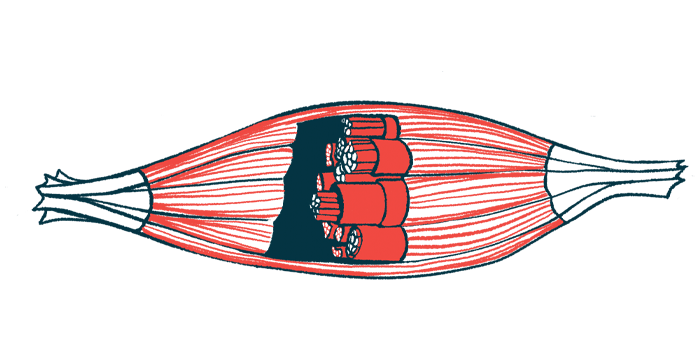At-home Muscle Test May Help Monitor LOPD
Written by |

Electrical impedance myography (EIM), a non-invasive and painless muscle test that can be conducted at home, is associated significantly with functional measures in adults with late-onset Pompe disease (LOPD), according to a small study.
Notably, similar EIM results were obtained when the test was performed by patients at home using a hand-held device and by investigators in the clinic, further supporting the use of a portable EIM device to remotely monitor muscle health in these patients..
Quantitative muscle ultrasound (QMUS), another non-invasive muscle test, also showed significant associations with some functional measures, and was able to detect a significant increase in fat replacement in the largest quad muscle over two years.
These findings support further evaluation of these non-invasive assessments in larger studies as potentially useful outcome measures for LOPD, the researchers noted.
The study, “Quantitative muscle ultrasound and electrical impedance myography in late onset Pompe disease: A pilot study of reliability, longitudinal change and correlation with function,” was conducted by a team of researchers at Duke University in North Carolina, and published in the journal Molecular Genetics and Metabolism Reports.
Assessing clinical change and response to interventions in LOPD can be challenging. Muscle biopsy, where a small sample of muscle tissue is collected and analyzed, is typically used to assess the effects of approved enzyme replacement therapies (ERT). Experimental treatments also are considered.
However, given its invasive and often painful nature, efforts increasingly have been made to identify non-invasive assessments that could be used to monitor disease progression in Pompe disease.
While muscle MRI is a non-invasive method used to identify fat replacement of skeletal muscles in LOPD patients, it is costly and not easy to perform in all patients. Fat replacement in muscle is associated with the severity of muscle impairment, making fat replacement a biomarker of muscle weakness severity.
As such, “non-invasive, inexpensive, point-of-care methods for assessing muscle health are needed for clinical trials and health tracking, particularly methods that can be performed at home,” the researchers wrote.
To address this, the team of researchers evaluated whether two non-invasive tools, EIM and QMUS, could provide sensitive, quantitative measures of muscle health and function in 25 LOPD patients (16 women and nine men) recruited at the Duke Pompe Clinic.
EIM involves the placement of electrodes over the selected muscle and the delivery of a painless, low electric current to collect information that can be used to determine muscle integrity. QMUS is an imaging tool that allows calculation of fat and muscle thickness, as well as fat replacement of normal muscle tissue.
Participants, with a mean age of 50.1 years, were evaluated through standard clinical measures, EIM, and QMUS at study’s start, and again at one year and two years. Clinical measures included those assessing upper and lower limb function, muscle strength, and quality of life and functional abilities.
Five patients also were asked to take home a hand-held, portable, commercially available EIM device (Skulpt) to perform additional measurements once a week for six weeks.
Most patients (92%) were on ERT at study start and continued treatment throughout the study. Only 13 patients completed all follow-up assessments, with the COVID-19 pandemic preventing completion of the last yearly visit of seven patients, the team noted.
Results showed that both hand-held EIM and QMUS were highly reliable measures: EIM to assess muscle quality and fat percentage, and QMUS to measure muscle and fat thickness.
Notably, there was no significant difference between EIM-based values collected through either the standard non-portable device at clinic visits or the portable muscle test device at home.
While portable EIM-based muscle quality or fat percentage did not change significantly over time, values for some of the evaluated muscles were associated significantly with several functional measures, such as grip strength, lower limb function, physical functioning, and ability to perform daily activities.
Also, QMUS showed a significant thickness increase in two arm muscles, but reduction in another, while fat thickness remained stable over time, in agreement with no major weight changes in these patients during the study period.
The level of fat replacement in vastus lateralis, the largest quad muscle, was increased significantly by 27% after two years, “a sign of declining muscle health,” the team wrote. This finding, along with the detected reduction in a forearm muscle thickness, suggest that QMUS may detect preclinical worsening, according to the investigators.
Moreover, QMUS-derived values for certain muscles also showed significant associations with several functional measures.
While “it seems unlikely that QMUS and [hand-held EIM] will surpass quantitative muscle MRI,” in monitoring muscle fat replacement and disease progression in LOPD patients, the findings suggest they “may provide useful outcome measures for future studies in LOPD,” the researchers wrote.
Larger longitudinal studies are needed to confirm the potential of these non-invasive, inexpensive measures, and to compare them with data from muscle MRI.
Notably, hand-held EIM “may be deployed into patients’ homes to allow them to track muscle health between clinic visits,” which also may “reduce travel burden, not only for clinical care, but for those individuals participating in research studies,” the team added.






